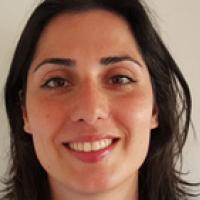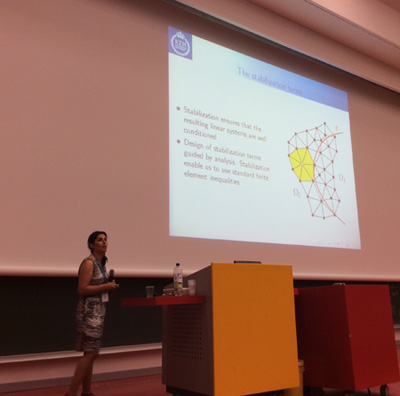
Blood, oil and water
People often say that mathematics is a language. For mathematician Sara Zahedi this was literally the case. The Iranian came to Sweden at the age of ten, alone, and without speaking a word of Swedish. It was through the maths she was doing at school that she made her first Swedish friends. "I made two friends that way," she says. "I found maths easy, and they were good at it too, so they started to discuss things with me because they realised that I also understood."

Sara Zahedi.
Since those school days Zahedi has gone far. We met at the European Congress of Mathematics in Berlin, where she won one of the prestigious prizes awarded to young mathematicians by the European Mathematical Society.
Unlike some of the other mathematics presented at the congress, Zahedi's work has direct uses in the world outside of maths. She tries to understand, and simulate on computers, the behaviour of fluids that don't mix together, like oil and water. It's the boundary between two such fluids, their interface, that Zahedi is interested in.
An example of the importance of this kind of problem comes from medicine. "It's something we think people will use in the future: a lab on a chip," explains Zahedi. "The idea is that instead of sending blood tests to a lab and waiting for a couple of weeks until you get the results, you take a small blood sample and perform lab processes on the chip, detecting viruses and bacteria within a few minutes." Such chips are expensive to produce, however, so it helps to simulate their function on a computer, getting the design right before actually manufacturing them. In these kind of lab tests blood interacts with other chemicals. Interfaces form and chemical processes happen on them.
Oil and water give us another example of why work like Zahedi's is important. The Deepwater Horizon oil spill that happened in the Gulf of Mexico in 2010 discharged nearly 5 million barrels of oil into the sea. "People didn't want this oil to reach land, so they added a lot of surfactants into the sea to make the oil soluble in water. The problem with this is that you don't really know what is going to happen, for example how it is going to effect sea life. Computer simulations could give you insight into this kind of complex problem too."
To create such simulations, you essentially face two problems. One is how to represent the changing geometry of the interface between two fluids in a computer. Zahedi and her colleagues came up with a way of doing this a few years ago, and it's been implemented in a commercial software package called Comsol.

Zahedi giving her prize lecture in Berlin.
The second problem is how to describe fluid processes that arise on such a changing interface, in which individual droplets can split, merge and generally deform in complex ways. For example, if a surfactant has been added, as in the oil example, how does its concentration change in such a dynamic setting? "As the fluid evolves the interface may get stretched or deformed and the concentration will decrease or increase," explains Zahedi. There are mathematical equations describing how the concentration will change, but the problem is that they are very difficult to solve. "In many cases we don't have a [neat mathematical formula that gives a solution]."
When there's no exact formula, the only way to describe the process on a computer is to find approximate solutions. Existing methods can do this very efficiently, even on complex geometric surfaces, but not on surfaces that change in complicated ways. Zahedi's method, which she has been awarded her prize for, can — and in a mathematically rigorous way to boot. "What is important for us is to be able to say how accurate the approximate solution is, and that's where the mathematics comes in from our point of view. We don't just want to design methods where there's no control over how big the error is." Zahedi's method not only finds approximate solutions, but also gives a way of telling how accurate those solutions are. "We are not quite there yet for the whole complex problem, but at least we can do it for model problems," she says.
The method has not yet been implemented in commercial software, but Zahedi thinks that it will be very soon. Your future medical diagnoses, and perhaps one day even the welfare of sea life, may depend on the clever piece of mathematics Zahedi has been honoured for.
About this article
Marianne Freiberger is Editor of Plus. She interviewed Sara Zahedi at the European Congress of Mathematics in Berlin in July 2016.
Comments
Reza
I'm very proud of her because I'm Iranian an mathematician.
Kourosh
I'm proud of her because seeing more women interested in mathematics and achieved the very high level of studies in this field.